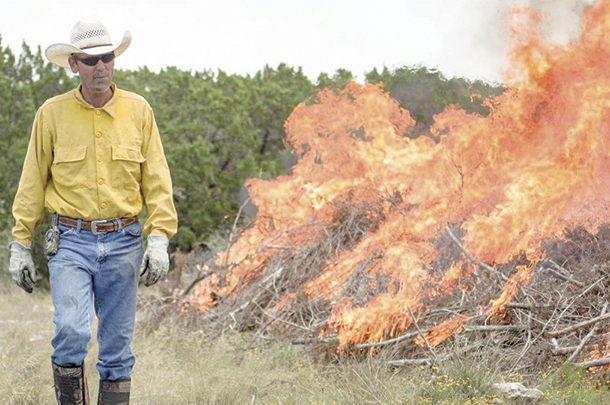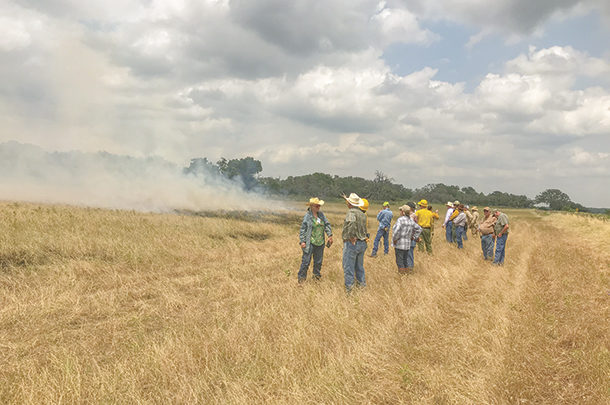Ranchers often use fire to help control or retard invasive species or brushy plants like juniper or cedar, create more forage for livestock or reduce fuel loads to help prevent catastrophic wildfires.
John Weir, extension specialist with Natural Resource Ecology and Management at Oklahoma State University, teaches classes on prescribed fire and fire ecology – season of burn, plant community impacts, etc. He also works with landowners and government agencies, providing training and assistance.
He says the main reason farmers and ranchers burn is for woody plant control, especially cedar encroaching on grasslands and prairies. “Kansas and Oklahoma together burn more than 3 million acres annually and do it safely and effectively,” Weir says.
“There’s not a very effective chemical means of control, especially for cedar, and mechanical brush control is costly. Fire is economical and provides more benefits. With fire we can increase forage production, plant health and vigor, palatability, crude protein and weight gains on livestock,” Weir says.
Amanda Rau, fire manager for The Nature Conservancy in Oregon/Washington and chair of the Oregon Prescribed Fire Council, works with the Prescribed Fire Training Exchange Program. “Most burning on private lands is done on their own because farmers don’t have the money to pay someone to come do a prescribed burn. We’ve been using private lands as places to train, in our Prescribed Fire Training Exchange Program, and the Nature Conservancy assumes responsibility for the burn. We are a large, insured organization with a lot of experience – doing prescribed fires since the 1950s,” she says.
“Our goal is to inspire people to learn to do it themselves, but we offer education. We do learn-and-burn events – pile burn workshops to get people started – and follow up with broadcast burn workshops,” she explains.
Prescribed burn associations in the Southeast and Midwest are self-organized, under a cooperative model. “Farmers and ranchers can create their own co-op. Nebraska co-ops are mostly oriented toward eradication of eastern red cedar encroaching on grazing lands; economic incentive is huge because they can see the amount of weight gain on cattle when they provide better pasture. Those ranchers are motivated to try to maintain or improve their pastures with burning,” she says.
“Those ranchers have the equipment to do the burns. Those are contiguous private lands – much less complicated than when federal, state and private lands are mixed. Here in the Willamette Valley, it’s a checkboard mix and more difficult to try to keep a fire within the private boundaries.”
Lenya Quinn Davidson organized a prescribed burn association in Humboldt County, in northern California, in March 2018, where ranchers were battling Douglas fir encroaching on oak woodlands and grasslands.
Prescribed fire councils
Most states have burn organizations, but these have been slower to form in the West. There are prescribed fire councils in Washington, Oregon, California and a new one in Wyoming. Arizona and New Mexico also do a fair amount of prescribed burning, but there are no prescribed fire councils yet in Idaho, Montana or Utah.
The council in Oregon is considering certified burner programs. “If individuals want to conduct burns on their land and go through training with the Department of Forestry, they have some alleviation of the liability associated with burning, and can apply fire to their lands,” says Rau.
In the Southeast, many landowners burn their property regularly. “It’s easier there. The terrain is not as challenging, and they never stopped burning, like we did. They don’t have the buildup of old fuels like the West has to deal with,” she explains.
Oregon has self-organized rural fire protection associations, mainly in ranching communities of central and eastern Oregon. “Their primary focus is fire-fighting because they are in an area where nobody is responsible for fire control,” says Rau. Eastern Oregon is outside the jurisdiction of the Department of Forestry, so ranchers created their own fire-fighting outfits.

“They also manage prescribed burning. No-smoke regulations apply there, and they don’t have to get a permit from the Department of Forestry. The ranchers work with rural fire protection associations to get their burning done. These groups have done substantial prescribed burns, mostly for reduction of woody species encroachment on grazing lands – mainly juniper – to reinvigorate range pastures to improve forage for cattle,” says Rau.
The permitting system is based on whether fire season is in effect. “If we’re not in fire season, it’s easy for folks to do a burn, but all the laws still apply. If, for some reason, a fire goes wrong and ends up on someone else’s land, you’d be responsible for it. This is where burn manager certification becomes important. If you get trained in how to do it properly, and do everything you are supposed to do and things don’t go well, you have some help from the state,” she says.
There are current efforts to get more prescribed burn councils started. Heather Heward (department of forest, rangeland and fire sciences, University of Idaho) has been trying to get a prescribed fire council started in Idaho. “In Oregon, it took us a while, and we’re still developing our program, but we are now official,” says Rau. “You must submit approved bylaws to the coalition, showing you have a set of working agreements with your group.” ![]()
PHOTO 1: Members of the Roger Mills Prescribed Burn Association in Oklahoma discuss progress during a prescribed burn. Photo provided by John Weir.
PHOTO 2: Keith Blair acts as burn boss during a controlled burn in Texas. Photo provided by Keith Blair.
Heather Thomas is a freelance writer based in Idaho.
Prescribed burning in Texas
Charles Kneuper, Texas state rangeland management specialist, USDA-NRCS, works with ranchers on grazing plans, which often include prescribed burns.
“Fire is one of the main disturbances that grazing lands in North America evolved with. The vegetation always experienced grazing (native herbivores: bison, elk, etc.), fire and drought, and became resilient and productive under those conditions. If we remove fire or grazing from the system, we often see unintended consequences,” says Kneuper. Buildup of old vegetation creates fuel for huge wildfires.
Prescribed fire is accomplished with a plan (prescription) for which fire will be applied. “This includes time of year, time of day, weather conditions – temperature, humidity, wind speeds and direction – and a certain fuel load. We know what the fire behavior will be, under that particular prescription,” Kneuper says.
Texas encourages prescribed burning. Morgan Treadwell (associate professor, extension specialist, Texas A&M, San Angelo, Texas) has had a lot of experience with prescribed burns, helping producers and government agencies learn about use of fire. “We want landowners to safely and effectively use prescribed burning to meet objectives. There are some regulations but, unless there’s a burn ban, any landowners can burn their property,” she says.
If they don’t feel confident or are unable to do the burning, they can work with NRCS or Texas Parks and Wildlife, or U.S. Fish and Wildlife Service. Any state or federal agency can assist with technical and financial help. Texas also offers a licensing program. “Landowners or managers can become certified through the Texas Department of Agriculture Prescribed Burn Program if they meet required standards. This involves taking a required curriculum (24 hours classroom work), passing a test and a certain amount of burn days as a burn boss,” says Treadwell.
Landowners or managers can apply for a private license to burn on their own property or property they manage, or apply to be a commercial burn manager. A not-for-profit category might include burning for a non-government organization or for research or teaching purposes. “Folks who are qualified or licensed through the Texas Department of Agriculture are given limited liability protection. This is beneficial, especially when prescribed fires are near urban-interface areas and must deal with smoke management,” she says.
Keith Blair operates Red Buffalo LLC, conducting prescribed burns on private range. He is a Texas certified burn manager and burn instructor, and offers prescribed burning workshops that include topics such as weather, fuel moisture, topography, fire effects, burn plans, etc. He has been doing prescribed burns since the 1980s. “With the fuel loads in most of Texas, it’s important to burn whatever we can in each season. In this area we are probably 200 years behind, with fuel buildup,” says Blair.











